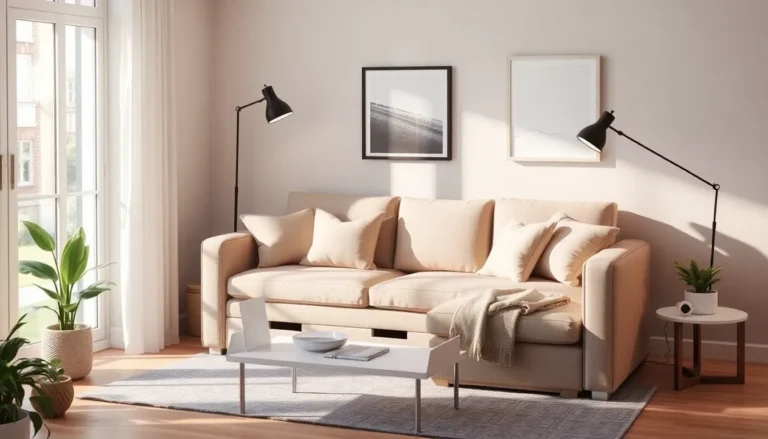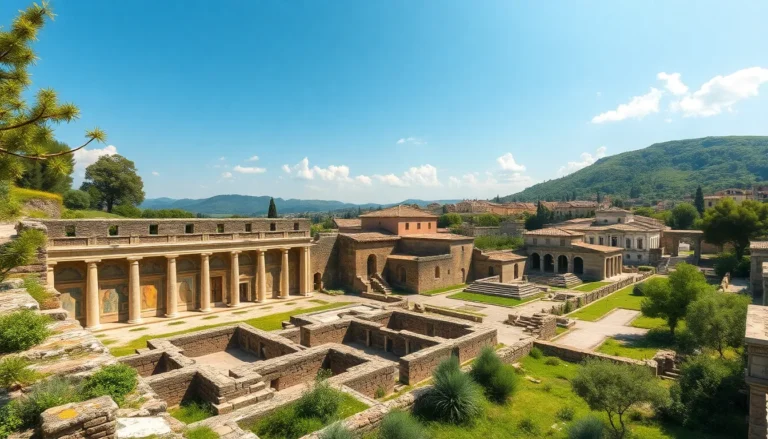Cupola architecture isn’t just about topping off a building; it’s about adding a crown jewel that makes heads turn. Imagine a charming dome peeking above a rooftop, catching the sun just right and whispering sweet nothings to passersby. These architectural wonders not only elevate aesthetics but also serve practical purposes, like providing light and ventilation.
But let’s be honest—who doesn’t want to live in a place that looks like it belongs in a fairy tale? Cupolas bring a touch of whimsy and elegance, transforming ordinary structures into extraordinary landmarks. Whether it’s a cozy cottage or a grand estate, these delightful domes make a statement that says, “I’m classy, but I can still throw a great party!” Dive into the world of cupola architecture and discover how these charming features can elevate any building from drab to fab.
Table of Contents
ToggleOverview of Cupola Architecture
Cupola architecture features prominent, often dome-shaped structures atop buildings, blending elegance and utility. Traditionally, cupolas serve as an integral architectural element, enhancing the visual appeal while offering essential functions like light, ventilation, and even viewing platforms.
Cupolas date back to ancient civilizations, seen in Roman and Byzantine architecture, and evolved through the Renaissance and Baroque periods. They appear in various styles, from classical to modern, and are typically made from materials like wood, metal, or glass.
Significantly, cupolas create striking silhouettes against the skyline, contributing to the aesthetic charm of structures. Their designs often include intricate detailing, such as finials or weather vanes, enhancing their decorative aspect. The interior of a cupola may incorporate windows, allowing natural light to flood interior spaces.
Cupolas also promote airflow, facilitating ventilation in attics or upper floors. This functionality helps regulate temperature, reducing reliance on artificial heating and cooling. Additionally, a well-placed cupola can function as a focal point, drawing the eye and creating a sense of visual hierarchy in a building’s design.
Pairing cupolas with specific architectural styles enriches overall design coherence. For instance, cupolas on colonial homes evoke a sense of tradition, while those on modern buildings might emphasize clean lines and minimalism.
Cupola architecture embodies a harmonious blend of beauty and practicality. Its enduring popularity stems from the ability to enhance both the function and form of structures, making them memorable landmarks in architectural landscapes.
Historical Significance

Cupola architecture showcases a rich historical significance, reflecting the cultural values and architectural advancements of various civilizations throughout time.
Ancient Origins
Cupolas trace their origins back to ancient civilizations, notably in Roman and Byzantine architecture. Romans integrated cupolas into temples and public buildings, symbolizing grandeur and divinity. Byzantine structures, such as the Hagia Sophia, featured massive domes that exemplified engineering prowess and religious significance. These early cupolas often served as focal points, drawing the eye upward and visually connecting terrestrial spaces with celestial realms.
Evolution Through the Ages
The Renaissance marked a major evolution in cupola design, as architects embraced classical elements and revived ancient styles. Prominent examples include St. Peter’s Basilica in Vatican City, where Michelangelo’s dome set a new standard for cupola aesthetics. The Baroque period introduced elaborate embellishments, enhancing cupolas’ grandeur and emotional impact. As architectural styles diversified, cupolas adapted, influencing various movements such as Neoclassicism and Victorian design, each adding unique characteristics while maintaining the cupola’s functional roles of light and ventilation.
Design Elements of Cupola Architecture
Cupola architecture features distinct design elements that blend functionality with visual appeal. Key aspects include structural features and aesthetic considerations, both contributing to the unique character of cupolas.
Structural Features
Cupolas exhibit a variety of structural features that enhance stability and functionality. They often incorporate a base that integrates with the roofline, ensuring seamless support. Typically dome-shaped, these structures distribute weight evenly, reducing stress on the underlying framework. They frequently utilize robust materials such as wood, metal, or glass, providing durability and weather resistance. Additionally, cupolas may include ventilation openings, allowing natural airflow to improve interior climate control. These structural elements not only ensure longevity but also facilitate the core functions of light and ventilation.
Aesthetic Considerations
Aesthetic considerations play a vital role in cupola design, contributing to a building’s identity. Often adorned with intricate detailing, cupolas feature elements such as decorative finials and weather vanes that enhance visual interest. They can vary in size and shape to complement different architectural styles, from classical to contemporary. Color choices and materials align with the structure’s overall design palette, reinforcing harmony. The prominent placement of cupolas elevates the skyline, creating striking silhouettes that attract attention. Such aesthetics not only enhance visual appeal but also embody the charm and elegance associated with cupola architecture.
Benefits of Incorporating Cupolas
Cupolas offer numerous advantages, enhancing both the aesthetic and functional aspects of buildings. Key benefits include natural lighting and improved ventilation.
Natural Lighting
Natural lighting is a primary benefit of cupolas. They feature windows strategically placed to maximize sunlight penetration into interior spaces. This influx of natural light reduces reliance on artificial lighting, lowering energy consumption. Properties with cupolas also benefit from bright, airy environments that enhance mood and productivity. Thoughtfully designed cupolas promote healthier living spaces while showcasing the unique architectural style of a building.
Ventilation and Airflow
Ventilation and airflow are crucial advantages provided by cupolas. Their elevated design allows warm air to escape, promoting a cooler atmosphere during warmer months. Adding operable windows facilitates cross-ventilation, which helps regulate temperature throughout the building. Enhanced airflow contributes to improved indoor air quality, minimizing humidity and odors. Cupolas serve as effective natural ventilators, ensuring a comfortable living or working environment while maintaining energy efficiency.
Famous Examples of Cupola Architecture
Cupola architecture boasts remarkable structures renowned for their beauty and utility. Many notable examples illustrate the charm and functionality of these architectural features.
Notable Buildings
Famous buildings featuring cupolas include St. Peter’s Basilica in Vatican City, an iconic representation of Renaissance architecture. The dome, designed by Michelangelo, showcases intricate details while providing light and ventilation. The Palace of Parliament in Bucharest features a massive cupola adorned with elegant detailing, symbolizing the nation’s architectural ambition. Another example is the Jefferson Memorial in Washington, D.C., which incorporates a central dome that enhances its neoclassical design while offering breathtaking views of the surrounding area.
Cultural Impact
Cupolas have significantly influenced various cultures and architectural movements. In Islamic architecture, cupolas, known as “mashrabiyas,” promote cooling and ventilation in hot climates. They appear in regions like North Africa and the Middle East, showcasing the adaptation of cupola design to local environmental conditions. In American colonial architecture, cupolas became synonymous with elegance, appearing in homes and public buildings, reflecting prosperity and societal values. Their presence in historic structures highlights cultural identity, blending functionality with artistic expression throughout history.
Cupola architecture stands as a testament to the fusion of beauty and function in design. These striking structures not only enhance the visual appeal of buildings but also play essential roles in lighting and ventilation. Their rich history reflects cultural values and architectural advancements across civilizations.
From ancient Rome to modern interpretations, cupolas continue to inspire architects and homeowners alike. Their ability to transform ordinary buildings into extraordinary landmarks is undeniable. As they grace skylines with elegance, cupolas remain a cherished element in the world of architecture, embodying a timeless charm that captivates all who behold them.




